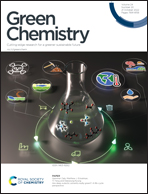Cocrystal engineering strategy for sustained release and leaching reduction of herbicides: a case study of metamitron†
Abstract
Due to the poor efficacy and environmental contamination caused by the ease of leaching, highly water-soluble herbicides have received considerable attention. For example, metamitron (MET), a herbicide that is used for controlling grass and broadleaf weeds in sugar beet fields, has led to a great threat to aquatic invertebrates because of its great migratory capacity. As a result, it is critical to control the release rate of MET applied in the field. Cocrystallization has been proven to be an effective strategy for dissolution property manipulation of pharmaceuticals and agrochemicals. However, few cocrystals of herbicides were reported for the release rate control. Herein, cocrystals of MET with cinnamic acid (CA), naringenin (NA), and baicalein (BA) were developed. Compared to pure MET, the dissolution rate of cocrystals MET–NA and MET–BA were dramatically decreased by 98.30% and 96.28%, respectively; the solubility of MET–NA and MET–BA were decreased by 95.49% and 96.21%. Leaching experiments showed that the leaching amounts of MET–NA and MET–BA in the soil were significantly reduced to roughly one-fifth of pure MET. Under simulated rainfall, the MET–NA and MET–BA showed a longer duration of action than pure MET. Additionally, crystal structure analysis and molecular dynamics simulations were conducted to reveal the mechanism of the sustained release effect of cocrystals MET–NA and MET–BA at a molecular level. This work demonstrates that cocrystal engineering can offer a promising strategy to achieve sustained-release efficacy and reduce environmental damage for highly water-soluble herbicides.



 Please wait while we load your content...
Please wait while we load your content...